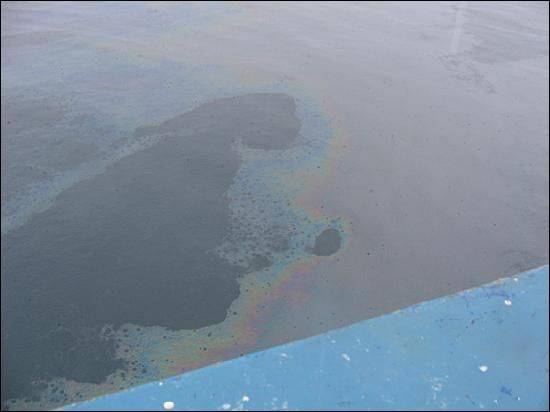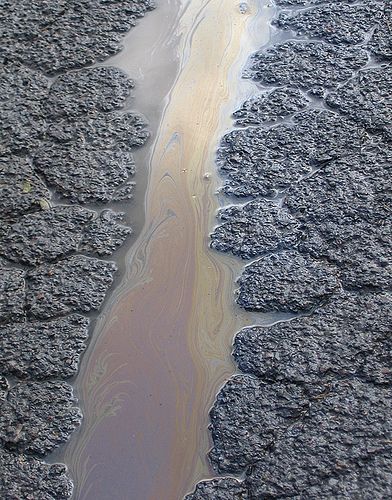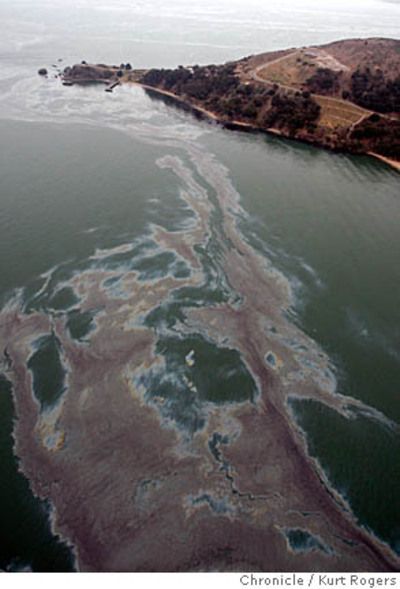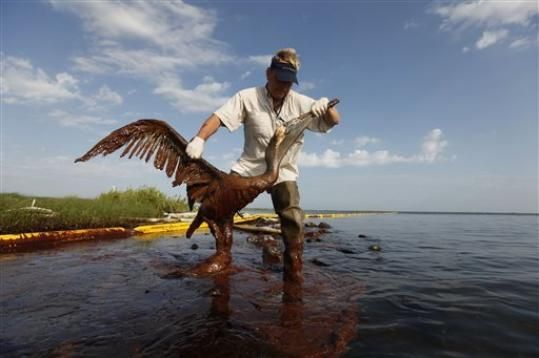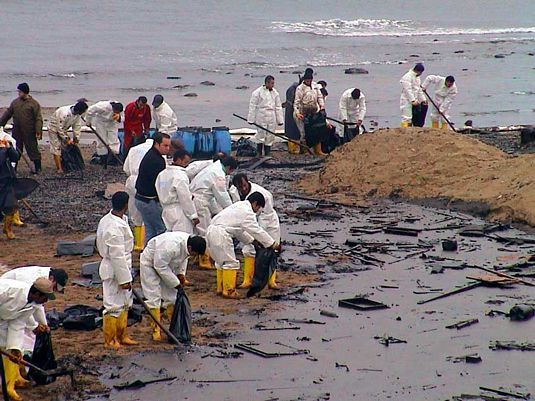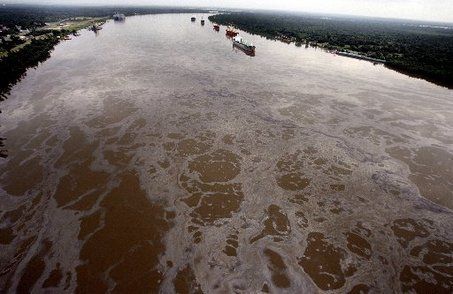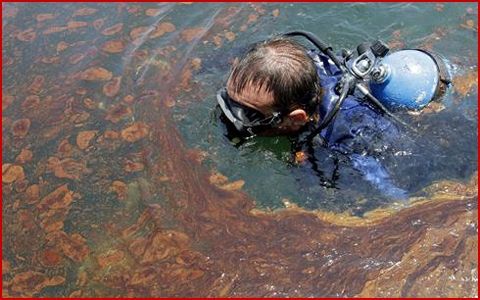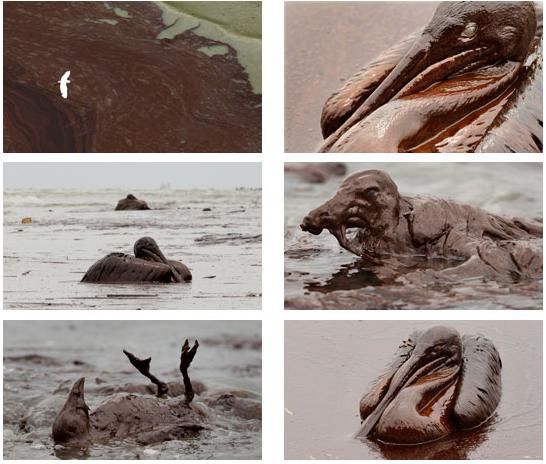It looks like you're using an Ad Blocker.
Please white-list or disable AboveTopSecret.com in your ad-blocking tool.
Thank you.
Some features of ATS will be disabled while you continue to use an ad-blocker.
share:
reply to post by OuttaTime
The plumes are not 100% oil. It is oil and gunk dispersed in the water column. So the volume of the plume will be much, much larger than the volume of the oil leaked.
The big problem with the plumes, besides the toxicity of the oil and dispersants, is the bacteria feeding frenzy that is taking place. The bacteria eats the oil, and multiplies out of control. In the process of eating and reproducing, the bacteria is sucking all of the oxygen out of the water, potentially creating huge "dead zones". No oxygen, no fish, no plankton, no life.
[edit on 11-6-2010 by moonwilson]
The plumes are not 100% oil. It is oil and gunk dispersed in the water column. So the volume of the plume will be much, much larger than the volume of the oil leaked.
The big problem with the plumes, besides the toxicity of the oil and dispersants, is the bacteria feeding frenzy that is taking place. The bacteria eats the oil, and multiplies out of control. In the process of eating and reproducing, the bacteria is sucking all of the oxygen out of the water, potentially creating huge "dead zones". No oxygen, no fish, no plankton, no life.
[edit on 11-6-2010 by moonwilson]

--------------------------------------------------------------------------------------
Wait a couple of days, after the Scientists finish reviewing the HD video footage, and if BP doesn't try to swap that cap without telling them so they can put flouresent ink into the well the numbers will probably be going up.
It's the worst environmental disaster in history...
AND IT'S ONGOING...
Oh and I got 260,000 barrels a day, you got 210,000.
I'm going with the 5% increase after they sawed off the Riser. I also think it's way more than 5%, probably 20% or more.
As you know BP is NOT a credible source of information, they lie and they are out to do damage control to protect their best interests --] Their business.
The Government is hiding it's head in the sand, and BP knows what game they are playing.
What a mess...
All you UFO buffs should learn from this incident, because this might shed some light on just how much information gets passed on to you from sources in the know.
[edit on 6/11/2010 by Brainiac]
I remember doing a little math equation and found that if it is 35000 barrels being lost a day then that would be the equivalent of 1% of the gas
stations in the U.S. being bone dry of gasoline. Thats if you were to bundle all the oil up and say to some gas station that they don't have the oil
for them to make the fuel. Most station's have anywhere from 2k to 10k gallons of gas. So I estimated 6k gallons for the 1% of gas stations number.
Originally posted by moonwilson
reply to post by OuttaTime
The plumes are not 100% oil. It is oil and gunk dispersed in the water column. So the volume of the plume will be much, much larger than the volume of the oil leaked.
The big problem with the plumes, besides the toxicity of the oil and dispersants, is the bacteria feeding frenzy that is taking place. The bacteria eats the oil, and multiplies out of control. In the process of eating and reproducing, the bacteria is sucking all of the oxygen out of the water, potentially creating huge "dead zones". No oxygen, no fish, no plankton, no life.
[edit on 11-6-2010 by moonwilson]
You're right there. Even going on a fraction of the amount I came up with, there is still massive amounts of oil. I agree with you that the oil is diluted with sea water, dispersant, bacteria, and so forth. I'm trying to get an accurate picture of how much oil already exists in the gulf. Trying to predict the amount of oil per day is become quite arduous, but if we know how much oil is already out there, then we can formulate an idea as to how much more to expect. I guess I'm trying to forecast the immensity of future impact and immensity of the black tide as I have family in Tampa.
I was trying to calculate the masses underwater versus trying to figure out the size of an iceberg by the size of the tip sticking out of the water.
FYI - This is why you can't Nuke the oil spill...
Also check out this 1955 prophecy about America, with the statue of liberty symbolically choking to death on gasses in the gulf of mexico...
www.angelfire.com...
[edit on 11-6-2010 by grom0007]
[edit on 11-6-2010 by grom0007]
Also check out this 1955 prophecy about America, with the statue of liberty symbolically choking to death on gasses in the gulf of mexico...
www.angelfire.com...
[edit on 11-6-2010 by grom0007]
[edit on 11-6-2010 by grom0007]
reply to post by Brainiac
SO... smarty pant's, I have seen all of the threads on this topic from all your Scientific Mars logarithmic thinking that just puts us another nano-second into the past(around and around we go when do we get off this Ferris wheel at Disney land?... But can anyone tell me when I can stop paying my mortgage payment and other bills... last I checked it still cost money to eat and breath and... O-Well I guess at least in the End I have some Gold when the world economy tanks that will buy me some super-frozen tuna from Japan('')... Dam it you mean it was really lead I bought... I never could figure out where that guy on the UFO talk shows was getting all that gold from('')
Jesus said, "Damn the flesh that depends on the soul. Damn the soul that depends on the flesh."
Mr X('')
Disclosure Project;
This is all for conspiracy entertainment purposes only and not to be taken as fact from from a Real-Stinker who probably has a hyper active imagination and lives in a basement unemployed with a big wiser-belly, so please consult with your Religious leader before taking any of this Seriously and use your own discretion in faith and judgment of the words... but who knows?
SO... smarty pant's, I have seen all of the threads on this topic from all your Scientific Mars logarithmic thinking that just puts us another nano-second into the past(around and around we go when do we get off this Ferris wheel at Disney land?... But can anyone tell me when I can stop paying my mortgage payment and other bills... last I checked it still cost money to eat and breath and... O-Well I guess at least in the End I have some Gold when the world economy tanks that will buy me some super-frozen tuna from Japan('')... Dam it you mean it was really lead I bought... I never could figure out where that guy on the UFO talk shows was getting all that gold from('')
Jesus said, "Damn the flesh that depends on the soul. Damn the soul that depends on the flesh."
Mr X('')
Disclosure Project;
This is all for conspiracy entertainment purposes only and not to be taken as fact from from a Real-Stinker who probably has a hyper active imagination and lives in a basement unemployed with a big wiser-belly, so please consult with your Religious leader before taking any of this Seriously and use your own discretion in faith and judgment of the words... but who knows?
Theres a good number of pages on here, and I havent been able to read all of them yet. Not sure if this has been posted yet.
Link
A new estimate came out yesterday that says its possible that 2.1 million gallons have been coming out daily. Plus, it says this spill may already be 7 times larger than the Valdeez one.
[edit on 11-6-2010 by buni11687]
[edit on 11-6-2010 by buni11687]
The spill — before June 3 when a riser was cut and then a cap put on it — was flowing at daily rate that could possibly have been as high as 2.1 million gallons, twice the highest number the federal government had been saying, according to U.S. Geological Survey Director Marcia McNutt, who is coordinating estimates.
A new estimate came out yesterday that says its possible that 2.1 million gallons have been coming out daily. Plus, it says this spill may already be 7 times larger than the Valdeez one.
[edit on 11-6-2010 by buni11687]
[edit on 11-6-2010 by buni11687]
I have not had a chance to read every post in this thread, but I will respond to those who have suggested the thickness assumption is wrong.
I don't know how anyone could look at the images of the various slicks and not conclude they are far thicker than a single coat of paint. This is on top of the untold amounts of dispersant used.
See for example:
Oil as thick as Chocolate Syrup
Ask yourself too, why this?
BP's Photo Blockade of the Gulf Oil Spill
I'll read all of the responses in this thread when I have time, but I have yet to see any compelling arguments against what I have written.
Frankly, I'm afraid the analogy is actually a weak one in the other direction. In other words, the oil is MUCH thicker than a single coat of paint...
[edit on 11-6-2010 by loam]
I don't know how anyone could look at the images of the various slicks and not conclude they are far thicker than a single coat of paint. This is on top of the untold amounts of dispersant used.
See for example:
Oil as thick as Chocolate Syrup
"...This isn't sheen or tar balls, this is thick sticky crude oil..."
May 22, 2010.
Ask yourself too, why this?
BP's Photo Blockade of the Gulf Oil Spill
I'll read all of the responses in this thread when I have time, but I have yet to see any compelling arguments against what I have written.
Frankly, I'm afraid the analogy is actually a weak one in the other direction. In other words, the oil is MUCH thicker than a single coat of paint...
[edit on 11-6-2010 by loam]
Wait a minute though, the oil is not one single solid slick, its lines and chunks f oil interspersed with sections of water...and its diluted...you
cant calculate the square milage that way...
Originally posted by loam
Problem number one. You can't just 'glance'. You need to read the actual links provided.
Cmon now. I never said I glanced over the OP, I said I glanced over the thread, meaning the rest of the thread. I get the feeling you responded to this and then read my post where I talk specifically about your links. Note that I responded to the 'thread', and the wild claim that the flow rate is increasing exponentially, and then I used the old "Reply to loam" code and went into your OP.
The 3x15 mile dimension is relative to the CONFIRMED underwater plume. It has nothing to do with the dimensions of the surface oil slick mentioned in the two previous articles. I cited the plume to further demonstrate that an additional very significant quantity of oil not accounted for in the surface area exists.
Right. You chose to use rhetorical qualitative assessment reports, that themselves contain no citations, over "CONFIRMED" quantitative 'official' data.
Why?
You would have been better off not having mentioned the latter because you in effect debunked yourself.
You could have tried to use that official number and used what I like to call volumetric math to try and calculate the volume of the oil spill, but you didn't. Don't feel bad, my math in that department is weak too.
You don't understand my math, and honestly I don't understand your English.
Do you not understand the the words qualitative and quantitative? How about mils? Do you know what mils are? Like I said a layer of paint would be a small handful of mils thick, and another ATS'er confirmed it to be 4 mils.
I have to ask this, been wondering for a while now: What credentials gives you that "Subject Matter Expert" badge?
I assume you could read the source to further to determine the answer. But again, it's graphic has nothing to do with the dozens of surface area representations cited by the literature and the corresponding calculations I made.
The "literature"? Are there some secret scholarly peer reviewed papers you're holding back on? All I saw was a 'news' report claiming that the source oil is "heavy crude" which is a total LIE, and then a CBS news article that quoted the transhumanist nutter Michio Kaku. A few month ago he said the sun is going to basically destroy the world in 2012 which is way over the top fearmongering, much like him screaming that the gusher will go unabated for years on end.
And then this buzzword "slick". You seem to be acting as if the stuff that's all around out there is a huge OIL SLICK. The source oil is sweet light crude, meaning 75% of it will evaporate. It isn't ALL tar.
Maybe you had a few drinks before posting this thread last night. I make strange threads from time to time when the Corona's are tasting real good I say this because if we were to take this math from your 'state scale' model you came up with here, and added to that the oil underwater, and the oil components already evaporated, and the natural gas, and the rest, we'd be looking at millions of barrels per day, which is totally ludicrous.
Anyways 'good times' as they say. A lot of other people have brought some other good perspective here and I hope to see you respond to all of it.
reply to post by IgnoranceIsntBlisss
To each his own. I won't convince you and you won't likely convince me.
None.
You get what you pay for.
Anywho....
Still waiting for real debunking.
*sigh*
[edit on 11-6-2010 by loam]
Originally posted by IgnoranceIsntBlisss
...a total LIE...
To each his own. I won't convince you and you won't likely convince me.
Originally posted by IgnoranceIsntBlisss
I have to ask this, been wondering for a while now: What credentials gives you that "Subject Matter Expert" badge?
None.
You get what you pay for.
Anywho....
Still waiting for real debunking.
*sigh*
[edit on 11-6-2010 by loam]
reply to post by grom0007
I mostly agree.
But where the oil aggregates, it is clear it far exceeds the thickness of a single coat of paint. If you consider the substantial amount of oil below, then is it all that unreasonable to assume the coverage is close if evenly distributed? Moreover, remember I even reduced the number by more than 40% to account for significant error and still came up with a staggering number.
[edit on 11-6-2010 by loam]
Originally posted by grom0007
Wait a minute though, the oil is not one single solid slick, its lines and chunks f oil interspersed with sections of water...and its diluted...you cant calculate the square milage that way...
I mostly agree.
But where the oil aggregates, it is clear it far exceeds the thickness of a single coat of paint. If you consider the substantial amount of oil below, then is it all that unreasonable to assume the coverage is close if evenly distributed? Moreover, remember I even reduced the number by more than 40% to account for significant error and still came up with a staggering number.
[edit on 11-6-2010 by loam]
My Question is this.
Why would BP lie or fail to tell us this amount of oil is being lost everyday?
Surely if these figures were true the government, BP or someone somewhere would let us know.
Also if this much oil is being lost we were never anywhere near peak oil. The cost of a barrel of oil should be going down because of all the untaped oil reserves around the world, not to mention the vast amounts of oil that will be availble from the gulf when they tap this thing.
Why would BP lie or fail to tell us this amount of oil is being lost everyday?
Surely if these figures were true the government, BP or someone somewhere would let us know.
Also if this much oil is being lost we were never anywhere near peak oil. The cost of a barrel of oil should be going down because of all the untaped oil reserves around the world, not to mention the vast amounts of oil that will be availble from the gulf when they tap this thing.
reply to post by bluloa
Frankly, if I were in BP's shoes, I too would see little upside in sharing the truth.
Frankly, if I were in BP's shoes, I too would see little upside in sharing the truth.
reply to post by IgnoranceIsntBlisss
"CONFIRMED" official sources?
You're joking, right?
"Officially", it was leaking 1,000 barrels a day, 5,000 barrels a day, 12,000 barrels a day, 20,000 barrels, 40,0000 barrels...officals are clueless or lying outright. BP has deliberately avoided letting any independent observers anywhere near the leak, released only poor video until forced to provide better. Officially, we know they lie.
Here's a better official report from Dr. Samantha Joye of the University of Georgia:
gulfblog.uga.edu...
She goes on to say that while microbial action is being supercharged by the oil's presence, and the bugs are eating the oil as fast as they can, their eating is depleting the oxygen at a frightening rate. Getting oxygen into the deep water is a very slow process; if the microbes remove the oil but leave the water anoxic and less saline, you've simply traded one bad problem for another bad problem.
And just to remind you: light, sweet crude evaporates only if it's on the surface, so your 75% evaporation rate is immaterial to the subsea plumes. Nothing you've offered to diminish the scope of the disaster holds up to reasonable analysis.
I understand why people want to downplay it, but mental toughness is required to face the reality and deal with it. The longer the "aww, it ain't so bad" crowd influences the response in any way, the more exponentially worse the disaster gets. If BP had told the truth from the beginning, we might have been able to save the marshlands, and with them the Gulf.
It's too late now: the Gulf is dying before our eyes and will be soiled for decades, no...make that, generations to come.
"CONFIRMED" official sources?
You're joking, right?
"Officially", it was leaking 1,000 barrels a day, 5,000 barrels a day, 12,000 barrels a day, 20,000 barrels, 40,0000 barrels...officals are clueless or lying outright. BP has deliberately avoided letting any independent observers anywhere near the leak, released only poor video until forced to provide better. Officially, we know they lie.
Here's a better official report from Dr. Samantha Joye of the University of Georgia:
How serious is the oxygen depletion problem?
Potentially, this is a very serious problem. At present, oxygen concentrations exceed 2 mg/L but if concentrations drop below that, it would spell problems for any oxygen requiring organisms. The Southwest Plume is, at a minimum, 15 miles long x 2 miles long and the plume is about 600 feet thick. Temperatures in the plume are about 8-12ºC. We do not know the absolute oil content at this time.
The plume is largely water. This is not thick oil like you see on the surface in some places, it’s diluted oil and it’s most concentrated closest to the leaking riser pipe. Unlike a natural oil seep, which is most intense on the bottom and whose signal decreases with depth above the seafloor, the plume we are studying starts 200m above the seafloor and its intensity decreases horizontally with distance away from the leaking wellhead.
The specific gravity of oil is irrelevant to this discussion. This is not oil like you buy at the auto supply store. Think of it as gas-saturated oil that has been shot out of a deep sea cannon under intense pressure – it’s like putting olive oil in a spray can, pressurizing it and pushing the spray button. What comes out when you push that button? A mist of olive oil. This well is leaking a mist of oil that is settling out in the deep sea.
gulfblog.uga.edu...
She goes on to say that while microbial action is being supercharged by the oil's presence, and the bugs are eating the oil as fast as they can, their eating is depleting the oxygen at a frightening rate. Getting oxygen into the deep water is a very slow process; if the microbes remove the oil but leave the water anoxic and less saline, you've simply traded one bad problem for another bad problem.
And just to remind you: light, sweet crude evaporates only if it's on the surface, so your 75% evaporation rate is immaterial to the subsea plumes. Nothing you've offered to diminish the scope of the disaster holds up to reasonable analysis.
I understand why people want to downplay it, but mental toughness is required to face the reality and deal with it. The longer the "aww, it ain't so bad" crowd influences the response in any way, the more exponentially worse the disaster gets. If BP had told the truth from the beginning, we might have been able to save the marshlands, and with them the Gulf.
It's too late now: the Gulf is dying before our eyes and will be soiled for decades, no...make that, generations to come.
Originally posted by loam
reply to post by IgnoranceIsntBlisss
Originally posted by IgnoranceIsntBlisss
...a total LIE...
To each his own. I won't convince you and you won't likely convince me.
FACT: The oil is Louisiana Light Sweet Crude, NOT "Heavy crude":
www.abovetopsecret.com...
That shows your citation-less article to be a farce. The other is Michio, as I said. He's a theoretical physicist, not an oil spill expert.
Therefore, your 2 QUALITATIVE articles are a joke. And as I said, your citation of the quantitative article basically debunks the main point of the thread.
Originally posted by IgnoranceIsntBlisss
I have to ask this, been wondering for a while now: What credentials gives you that "Subject Matter Expert" badge?
None.
So you're not an actual professional in some field relevant to ATS, which is how one is supposed to be able to get that? They could have just made you a mod instead of bend the rules on their badge system, but whatever.
[edit on 11-6-2010 by IgnoranceIsntBlisss]
reply to post by apacheman
Don't forget all with the government's complicity, imo.
Originally posted by apacheman
BP has deliberately avoided letting any independent observers anywhere near the leak, released only poor video until forced to provide better. Officially, we know they lie.
Don't forget all with the government's complicity, imo.
Hey, thanks for the post. Did you notice how the media was trying to confuse the numbers? At first, they were measuring the amount of oil in barrels.
It seems like a relatively small number, if you don't know the difference between gallons and barrels, or aren't quick enough to catch the
difference. Then, when the cap was in place, they switched to gallons. Say, it was leaking 900,000 barrels before, when the cap was in place, it's
catching 400,000 gallons. Did you catch that? When you play with words like that, it sounds like it's capturing most of the oil; when in reality,
it's more like going to the ocean and taking a thimble-full of water away. What makes me really angry is that they think people are too stupid to
catch how they spin things.
reply to post by loam
The problem is that you are looking at pictures on the coast. And the oil will accumulate there and isn't an accurate picture of the slick out in the gulf.
Again...I'm not saying my numbers are correct. But neither can you say yours are correct by just randomly picking paint as your comparison for thickness.
You are using a thickness of approximately 0.0045...which is a 100% fine thickness for your paint example. But paint on a wall...not in water...even paint would spread thinner over water (if it floated). But we aren't talking about paint...we are talking about oil.
If you don't want to believe the numbers...that is fine...but you can't use the oil accumulated on the shore as justification that the oil slick out in the gulf is thicker than what the sources I posted are saying.
All I did was find sources that showed the thickness of oil slicks...I don't know what else to do but to go by those numbers. I can't just make up a thickness and run with it...I have to go by the data that is available.
You asked for your numbers to be debunked...and I showed that your thickness you are using...using sources to back it up...is off...way off. That is all I can do.
I don't know how anyone could look at the images of the various slicks and not conclude they are far thicker than a single coat of paint. This is on top of the untold amounts of dispersant used.
The problem is that you are looking at pictures on the coast. And the oil will accumulate there and isn't an accurate picture of the slick out in the gulf.
Again...I'm not saying my numbers are correct. But neither can you say yours are correct by just randomly picking paint as your comparison for thickness.
You are using a thickness of approximately 0.0045...which is a 100% fine thickness for your paint example. But paint on a wall...not in water...even paint would spread thinner over water (if it floated). But we aren't talking about paint...we are talking about oil.
If you don't want to believe the numbers...that is fine...but you can't use the oil accumulated on the shore as justification that the oil slick out in the gulf is thicker than what the sources I posted are saying.
All I did was find sources that showed the thickness of oil slicks...I don't know what else to do but to go by those numbers. I can't just make up a thickness and run with it...I have to go by the data that is available.
You asked for your numbers to be debunked...and I showed that your thickness you are using...using sources to back it up...is off...way off. That is all I can do.
new topics
-
If they can see...they can read!!
Rant: 1 hours ago -
Tesla Cybertruck Explodes in Front of Trump Hotel in Las Vegas
Mainstream News: 7 hours ago -
Maybe they didn't get away with it: The Lincoln-Kennedy assassination parallels. 7 sentences long.
History: 9 hours ago
top topics
-
Vehicle Strikes people in New Orleans
Mainstream News: 17 hours ago, 24 flags -
Tesla Cybertruck Explodes in Front of Trump Hotel in Las Vegas
Mainstream News: 7 hours ago, 16 flags -
Ukraine halts transit of Russian gas to Europe after a prewar deal expired
Political Conspiracies: 13 hours ago, 11 flags -
Welp...Happy New Year!!
General Chit Chat: 15 hours ago, 8 flags -
The Hand that Rocks the Cradle - Labour Plans “diversities of our society” Curriculum Change
Regional Politics: 17 hours ago, 6 flags -
Maybe they didn't get away with it: The Lincoln-Kennedy assassination parallels. 7 sentences long.
History: 9 hours ago, 4 flags -
If they can see...they can read!!
Rant: 1 hours ago, 4 flags
active topics
-
If they can see...they can read!!
Rant • 4 • : rickymouse -
Tesla Cybertruck Explodes in Front of Trump Hotel in Las Vegas
Mainstream News • 47 • : yuppa -
Vehicle Strikes people in New Orleans
Mainstream News • 240 • : starvosan -
US disburses $3.4 billion in budget aid for Ukraine, Yellen says
US Political Madness • 25 • : VariedcodeSole -
I dont understand what i just witnessed
Social Issues and Civil Unrest • 28 • : Daughter2v2 -
Remember These Attacks When President Trump 2.0 Retribution-Justice Commences.
2024 Elections • 118 • : WeMustCare -
Ukraine halts transit of Russian gas to Europe after a prewar deal expired
Political Conspiracies • 103 • : ThinkinCap -
Can someone 'splain me like I'm 5. Blockchain?
Science & Technology • 98 • : TzarChasm -
Happy New Year from Aussie
General Chit Chat • 23 • : bally001 -
Get Ready - Here comes the Bird Flu Pandemic - Millions are Notified
Diseases and Pandemics • 64 • : cherokeetroy

